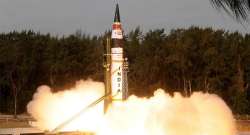India successfully test-fires nuclear-capable Agni-5 missile off Odisha coast
India has in its armoury the Agni missile series -- Agni-1 with a range of 700 km, Agni-2 with a range of 2,000 km, Agni-3 and Agni-4 with 2,500 km to more than 3,500 km range.

India successfully test-fired nuclear-capable ballistic missile Agni-5, which has a strike range of 5,000 km, from Dr Abdul Kalam Island off the Odisha coast Monday. This is the seventh trial of the indigenously-developed surface-to-surface missile, defence sources said. Agni-5 is a three-stage missile and is 17 metre tall and 2 metre wide. It is capable of carrying 1.5 tonne of nuclear warheads.
"The missile was launched with the help of a mobile launcher from launch pad-4 of the Integrated Test Range (ITR) at Dr Abdul Kalam Island in the Bay of Bengal on Monday afternoon," said a defence source.
"It was an user associated trial. Strategic force command along with DRDO scientists conducted it," the source added.
During this trial, the flight performance of the missile was tracked and monitored by radars, tracking instruments and observation stations, said the source.
India has in its armoury the Agni missile series -- Agni-1 with a range of 700 km, Agni-2 with a range of 2,000 km, Agni-3 and Agni-4 with 2,500 km to more than 3,500 km range.
The Agni-5 is the latest and most advanced variant in terms of navigation and guidance, warhead and engine.
"The high-speed on-board computer and fault-tolerant software, along with robust and reliable bus guided the (Agni-5) missile flawlessly (during the test)," an official said.
The missile is programmed in such a way that after reaching the peak of its trajectory, it turns towards the earth to continue its journey to the target with an increased speed, due to the earth's gravitational pull, and its path precisely directed by the advanced on-board computer and inertial navigation system.
As the missile enters the earth's atmosphere, the atmospheric air rubbing its outer surface skin raises the temperature to beyond 4,000 degree Celsius.
However, the indigenously-designed and developed heat shield maintains the inside temperature at less than 50 degree Celsius.
Finally, commanded by the on-board computer with the support of laser gyro-based inertial navigation system, micro inertial navigation system (MINS), fully digital control system and advanced compact avionics, the missile hit the designated target point accurately, meeting all mission objectives, the sources said.
The ships located in mid-range and at the target point tracked the vehicle and witnessed the final event.
All the radars and electro-optical systems along the path, monitored the parameters of the missile and displayed them in real time.
The first two flights of Agni-5 in 2012 and 2013 were in open configuration. The third, fourth and fifth launch were from canister integrated with a mobile launcher, that enables launch of the missile in a shorter time as compared to an open launch.
The missile has advantages of higher reliability, longer shelf life, less maintenance and enhanced mobility.
The first test was conducted on April 19, 2012, the second on September 15, 2013, the third on January 31, 2015 and the fourth one on December 26, 2016.
The fifth test was held on January 18 this year and the last one was held on June 3, 2018. All the trials were successful.